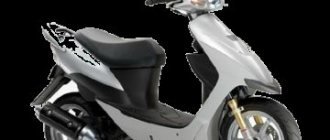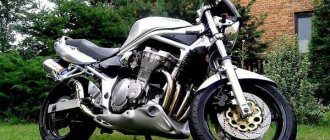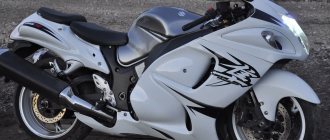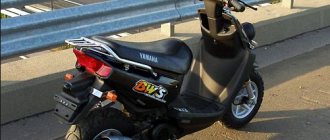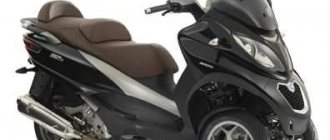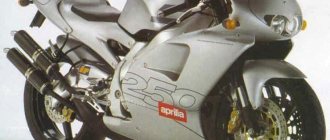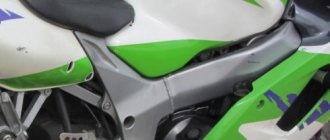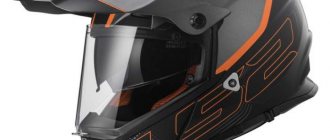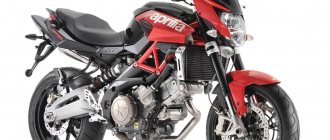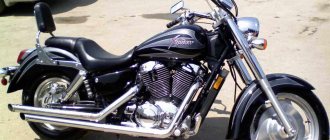Suzuki has always produced high-quality equipment, which has become one of the best on the market. And when the excellent Suzuki Lets scooter came out, the manufacturer saw great potential.
Then it was the Lets model that opened the company’s range of scooters, which gave it unprecedented popularity. The scooters were durable, stylish and great for young people. With proper characteristics, the model could reach speeds of up to 60 km/h, which is the norm for this type today. Like all vehicles, the Suzuki Lets 2 has several drawbacks.
pros
- very low fuel consumption;
- comfortable fit and seat position;
- modern and practical appearance;
- a true example of Japanese scooters.
Minuses
- weak headlight light;
- cannot tolerate snowy weather.
Technical characteristics of Suzuki Lets 2
Today's Suzuki Lets 2 are of quite high quality, because throughout its long existence the moped has received a number of improvements and modifications. The Lets model acquired a fairly simple air-cooled engine operating in 2 strokes. It was the two-stroke modifications that were much better than the 4-stroke ones, because they had a simpler design and worked faster than their competitor.
The Suzuki Lets 2 moped had one important drawback of the engine - a high noise level. But despite this, he enjoyed wild popularity. With a thrust of 7.3 Nm, the driver could make sharp starts or easily carry one passenger.
80s - Suzuki SWANY SPORT, LOVE, SYOBI, LOVE THREE, ADDRESS TUNE
The Suzuki SWANY SPORT scooter was first released in 1981, designed for an audience of housewives. Its appearance was a revolutionary event.
Suzuki swanysport
Lightness, versatility, reliability, quality and economy, this is everything everyone wants from the miniature cousins of motorcycles. The history of Suzuki scooters is not so long, but very rich.
The next model was released in 1982 and was called LOVE. It became very popular due to the fact that Michael Jackson had a similar model.
Suzuki Love
In 1983, another women's scooter appeared - SYOBI, light in driving and in weight. Total 41 kg.
Review of Suzuki Lets 2
The world first learned about Suzuki Lets 2 back in 1996. At that time, the Japanese had already made a high-quality scooter, the design of which was soon adopted by other manufacturers. But the company did not finish there, and then in 1999 a new modification, Suzuki Lets 2 New, was released. Its main difference was new forms, a streamlined design and excellent lighting technology.
Like any other Japanese scooter, the new product has high-quality and durable plastic with smooth lines. In general, the entire design of the moped is very well thought out, because any necessary part can be easily reached. The manufacturer also took care of transportation, so a small basket was installed in front and a large luggage compartment under the seat. A helmet can easily fit there.
The company has always made clear and informative technology, which is why the dashboard has fuel indicators, an odometer, and even a “check engine” indicator. Tuning Suzuki Lets 2 is quite simple, because the design and construction of the model itself allow for a minimum of modifications. For the most part, this is a plus, because the Suzuki Lets 2 is quite simple and practical; major external tuning will only be a disadvantage for it. To improve the technical characteristics, you can install a different variator belt and play with the weight of the weights on the scooter. If you choose the optimal weight, your vehicle can accelerate to 75 km/h.
Repairing Suzuki Lets 2 is also simple and affordable, because spare parts for it are almost the most popular on the motorcycle market today. You can choose from Chinese, Taiwanese or original Japanese parts. It is strongly recommended not to buy Chinese spare parts, as they will primarily harm your scooter. The best option would be to purchase Taiwanese spare parts.
Suzuki Let's 5
The Japanese city scooter Suzuki Lets 5 (Suzuki Lets) is one of the most compact and lightweight devices from the Lets series family
It can be called a modern, convenient and economical means for comfortable movement along crowded city streets. Its short length, weight of 62 kg and gasoline consumption of 1.5 liters per hundred attract many fans of this brand.
This one began production in 2010. It replaced the then popular Suzuki Lets 4 moped, which had been on the assembly line for the previous 4 years. In fact, all the changes affected only the external design without any significant innovations or improvements in the technical part of the scooter. But the designers did their job with a solid A+.
The moped has become prettier, more recognizable, with its own distinctive features, such as the original appearance of the rear light and a bold decision in the location of the front turn signals. Another feature of the model was the spacious opening glove compartment next to the dashboard. This innovation in design was positively received by all Lets 5 owners, as it carried not only originality, but also direct functional load; almost any phone or necessary trifle that should be periodically at hand could easily fit into this department.
The company's engineers did a very good job on safety and protected the moped as much as possible from theft. In addition to the standard key with a special magnet and a shutter on the ignition switch, they added a full-fledged alarm system with an “Alarm” indicator light displayed on the instrument panel. The operating principle of this system is quite simple and at the same time reliable: when the ignition is turned off and the steering wheel is locked, the alarm system automatically turns on, which will be indicated by a flashing light on the dashboard. As soon as there is an unauthorized attempt to start the engine in this position, a loud siren will immediately turn on, which will work until it is completely mechanically unlocked with the standard key.
In other technical terms, much remains unchanged. The power unit has a volume of 50 cm3 and four strokes per cylinder. Engine cooling is forced air, which is carried out by means of a fan mounted on the engine crankshaft. Fuel supply is controlled by a full injector, which provides amazingly low gas mileage in the urban cycle.
The suspension and braking system are the most classic and most reliable for a moped of this class. There are indestructible drum brakes at the front and rear, which work in conjunction with conventional spring shock absorbers. This combination requires virtually no repairs, and maintenance can be performed at extended intervals. Overall, this is a very convenient and comfortable city assistant for people of absolutely any age and driving skill. Quiet dynamics can forgive many mistakes for a beginner, and the existing power reserve can please an advanced pilot.
The enhanced anti-theft system is a definite plus when choosing this scooter. Also, the presence of roomy space under the seat and a small pocket on the steering wheel makes the model more attractive in relation to its competitors. Bright design, efficiency and thoughtful functionality are the main trump cards of the city scooter Suzuki Lets 5. This is why this model is so loved not only in Japan, but throughout the world.
You can buy this scooter inexpensively in our stores located in convenient places in Moscow. If necessary, equipment is delivered using the company’s own transport or third-party carriers.
Review of Suzuki Lets 2
I bought the scooter secondhand. y, but the owner assured of its quality and reliability. That’s how it turned out, despite the mileage of 2,000 km, I got a very fast machine. I tested it a little for maximum speed, and in the very first test, the Suzuki Lets gave a maximum speed of 55 km.
I also tested it for load capacity, and I’ll tell you straight, for its size the scooter is a real beast. Once I was riding with my wife and a whole sack of potatoes, but the iron horse showed itself perfectly. In my situation, the average fuel consumption was 2.5 liters/100 km. The only thing I didn’t like was that the light from the front headlight was too weak, it was hard to see the road at night.
Suzuki Let's 4 Pallet scooter review
From 2005 to 2010, manufacturers included Japanese 50cc Let's 4 Pallet scooters in their line of Suzuki Let's models. Let's 4 one and a half seat urban models, easy to use, with excellent driving characteristics. The scooters were produced in two design styles: retro, with a round headlight, and modern, with a rectangular headlight.
Almost during the same period of time, Japanese 100cc sports scooters Suzuki Address V 110 and V 115 were produced. These models belong to the class of two-seater maxi scooters. Despite their small size, they have increased dynamics and speed acceleration of up to 100 km/h.
A comparative review of the Let's scooter reveals the current trend of Suzuki - to use environmentally friendly, four-stroke engines on 50 and 100 cc models. The Address V 110 uses a two-stroke engine, while the V 115 scooter uses a four-stroke engine.
Pallet became the first in the 50 cc Let's family with an economical four-stroke engine and, thanks to this quality, is popular with city residents who do not have a high level of income. Buyers are also attracted by the fact that scooters of recent years are distinguished by increased durability and high maneuverability.
Lets 4 models are equipped with injection, compact engines. The motor is light in weight and economical, like all four-stroke engines, so the scooter’s consumption is only 1.25 liters per 100 km at a speed of 30 km/h. Standard AI-95 gasoline consumption for city traffic is 1.5 liters. Structurally, on all Lets models, the engines are reliably protected by the scooter body.
It's always interesting to review scooters that have been improved structurally. The new Let's 4 Pallet has the lowest weight in its class, only 62 kg. The suspension is classic, reliable, telescopic in the front, shock absorber in the rear. The brakes are of the usual drum type, but their design has been improved and strengthened, as it should be for scooters with increased maneuverability.
Technical characteristics of Let's 4 Pallet:
| Length — 1665 mm Width — 635 mm Height — 1150 mm Seat height — 685 mm Base — 1150 mm Ground clearance — 105 mm Fuel tank — 4.5 l Oil tank — 0.8 l Dry weight — 62 kg Drum brakes Front wheel — 80/90-10_35J Wheel rear — 80/90-10_35J | Engine—four-stroke A404 Cooling—forced air Volume—49cm? Cylinder 1 - diameter 39.0 mm Piston stroke - 41.8 mm Compression - 10.7 Max power - 5.0 hp. at 8000 rpm Torque - 4.6 Nm at 6500 rpm Max speed - 60 km/h Carburetor Electric starter kick starter Transmission - CVT |
Currently, Pallet scooters are purchased by dealers in Japan, the average auction price of a scooter is 139 thousand yen. In Russia, new scooters with a three-year warranty are sold at prices ranging from 45 thousand rubles and above. A used scooter can cost $650. Since 2005, scooters with injection engines have been produced in China.

